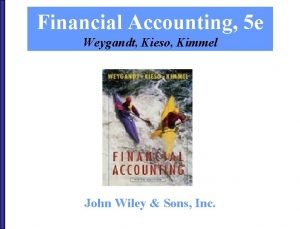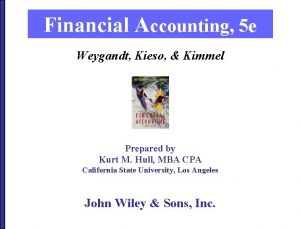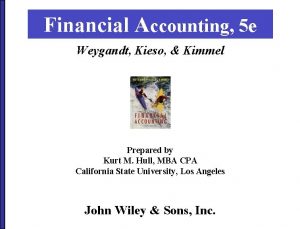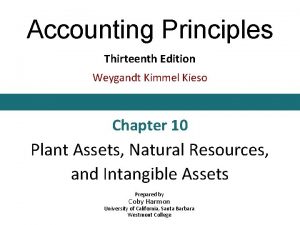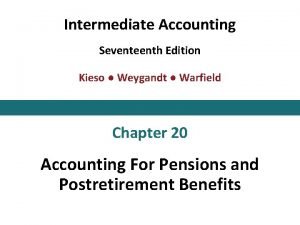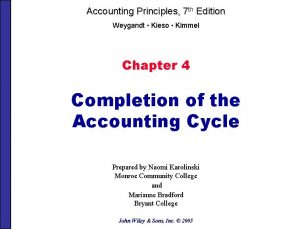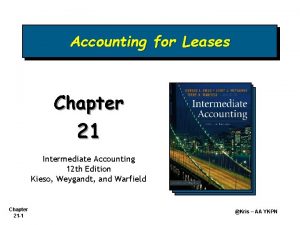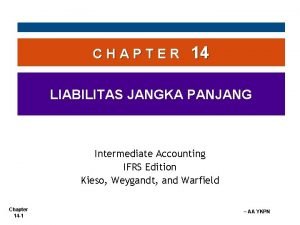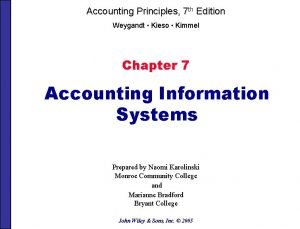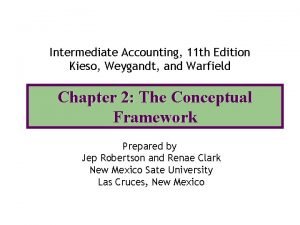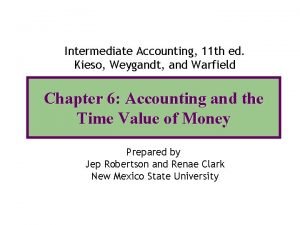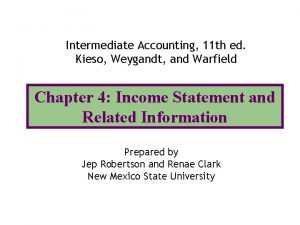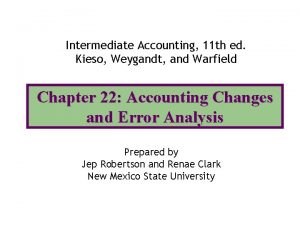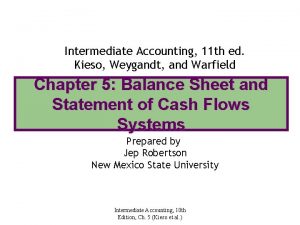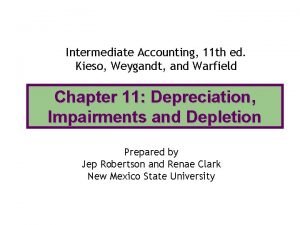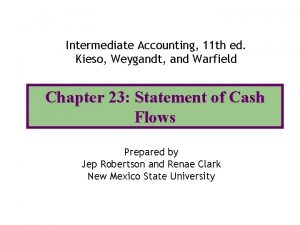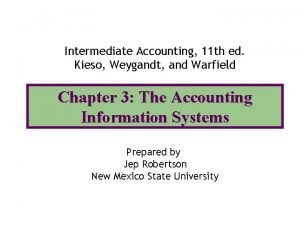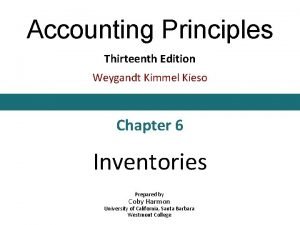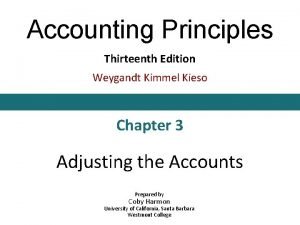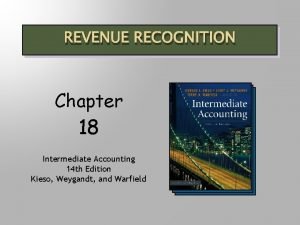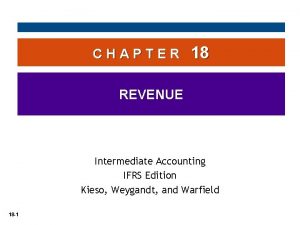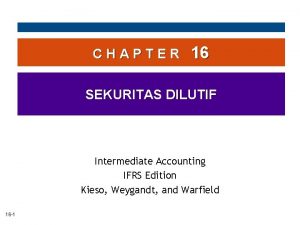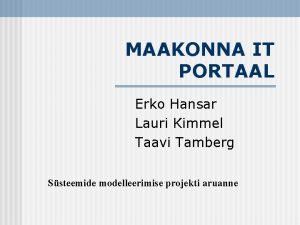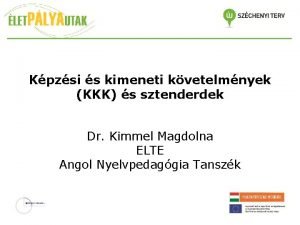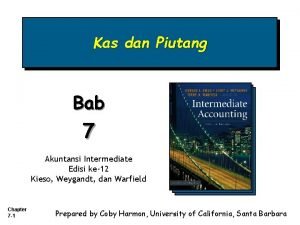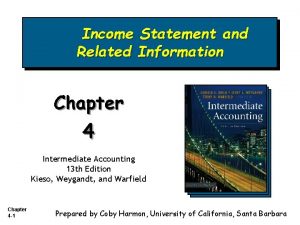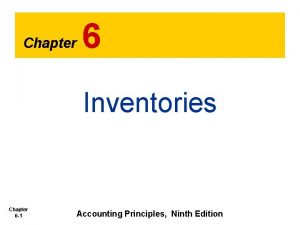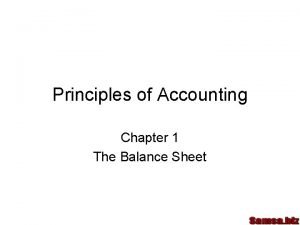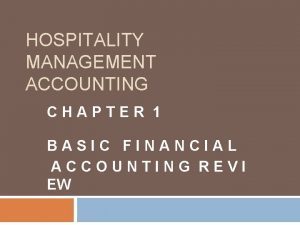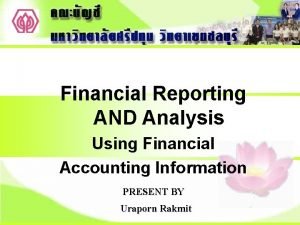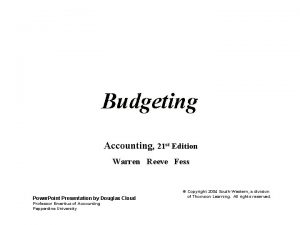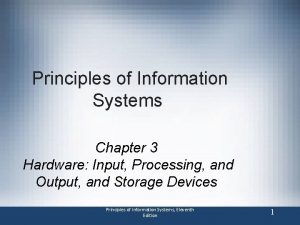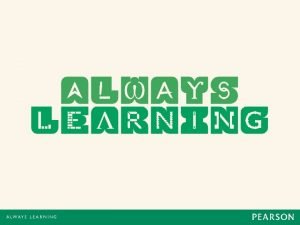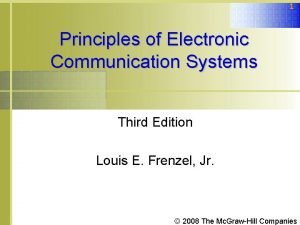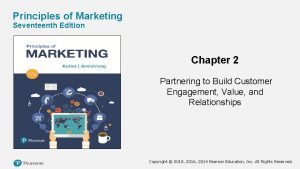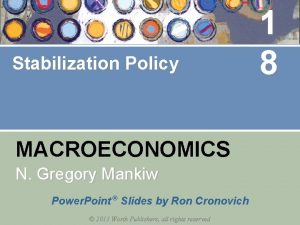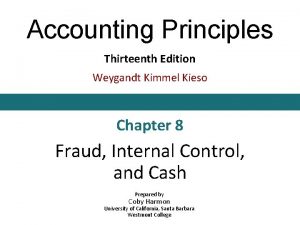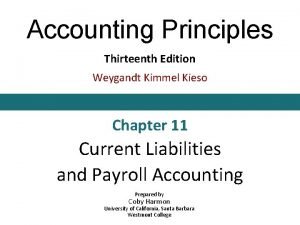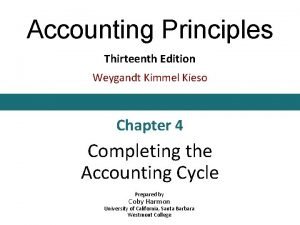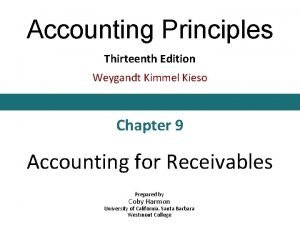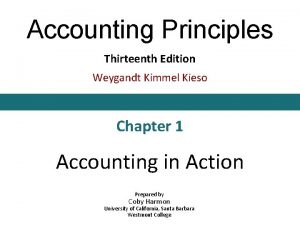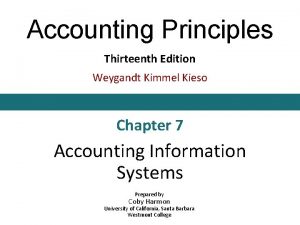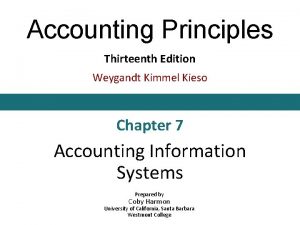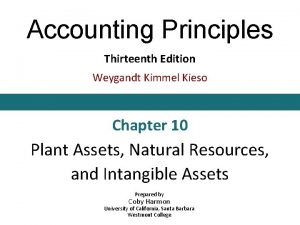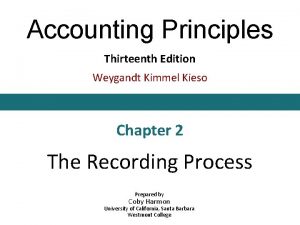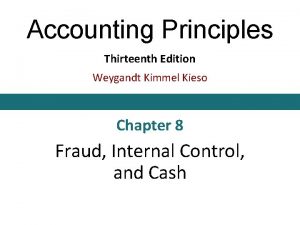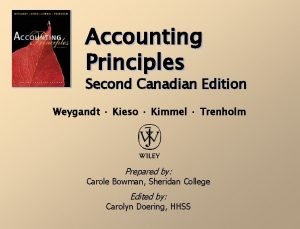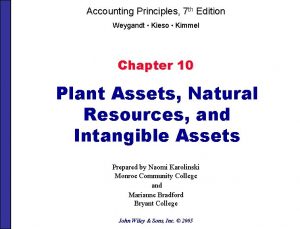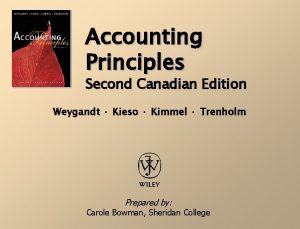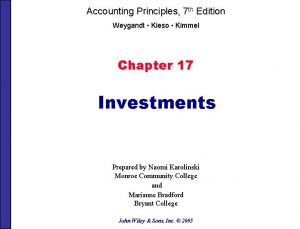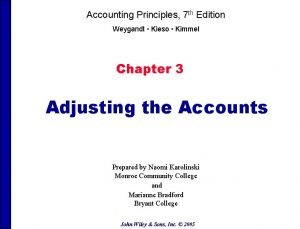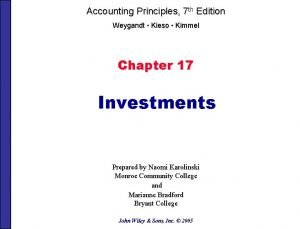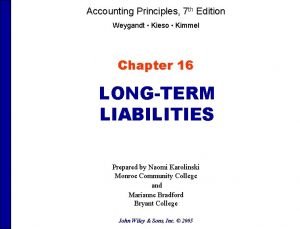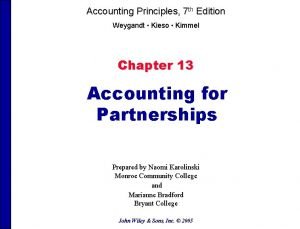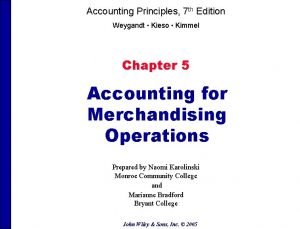Accounting Principles Thirteenth Edition Weygandt Kimmel Kieso Chapter































































- Slides: 63

Accounting Principles Thirteenth Edition Weygandt Kimmel Kieso Chapter 6 Inventories Prepared by Coby Harmon University of California, Santa Barbara Westmont College

Inventories Preview Classifying and Determining Inventory • Classifying inventory • Determining inventory quantities Inventory Costing Inventory Errors • Specific identification • Cost flow assumptions • Financial statement and tax effects • Consistent use • Lower-of-costor-market • Income statement effects • Balance sheet effects Statement Presentation and Analysis • Presentation • Analysis

Chapter Outline Learning Objectives LO 1 Discuss how to classify and determine inventory. LO 2 Apply inventory cost flow methods and discuss their financial effects. LO 3 Indicate the effects of inventory errors on the financial statements. LO 4 Explain the statement presentation and analysis of inventory. Copyright © 2018 John Wiley & Son, Inc. 3

Classifying and Determining Inventory Classifying Inventory Merchandising Company One Classification: • Inventory LO 1 Manufacturing Company Three Classifications: • Raw Materials • Work in Process • Finished Goods Copyright © 2018 John Wiley & Son, Inc. 4

Determining Inventory Quantities Physical Inventory taken for two reasons: Perpetual System 1. Check accuracy of inventory records. 2. Determine amount of inventory lost due to wasted raw materials, shoplifting, or employee theft. Periodic System 1. Determine the inventory on hand. 2. Determine the cost of goods sold for the period. LO 1 Copyright © 2018 John Wiley & Son, Inc. 5

Determining Inventory Quantities Taking a Physical Inventory Involves counting, weighing, or measuring each kind of inventory on hand. Companies often “take inventory” • when business is closed or business is slow • at the end of accounting period LO 1 Copyright © 2018 John Wiley & Son, Inc. 6

Determining Inventory Quantities Determining Ownership of Goods in Transit • Purchased goods not yet received • Sold goods not yet delivered • Included in inventory of company that has legal title to goods LO 1 Copyright © 2018 John Wiley & Son, Inc. 7

Goods in Transit Ownership of goods passes to buyer when public carrier accepts goods from seller. Ownership of goods remains with seller until the goods reach buyer. ILLUSTRATION 6. 2 Terms of sale LO 1 Freight costs incurred by the seller are an operating expense. Copyright © 2018 John Wiley & Son, Inc. 8

Goods in Transit Goods in transit should be included in the inventory of the buyer when the: a. public carrier accepts the goods from the seller b. goods reach the buyer c. terms of sale are FOB destination d. terms of sale are FOB shipping point LO 1 Copyright © 2018 John Wiley & Son, Inc. 9

Determining Ownership of Goods Consigned Goods To hold the goods of other parties and try to sell the goods for them for a fee, but without taking ownership of the goods. Many car, boat, and antique dealers sell goods on consignment, why? LO 1 Copyright © 2018 John Wiley & Son, Inc. 10

DO IT! 1 Rules of Ownership Hasbeen Company completed its inventory count. It arrived at a total inventory value of $200, 000. As a new member of Hasbeen’s accounting department, you have been given the information listed below. Discuss how this information affects the reported cost of inventory. 1. Hasbeen included in the inventory goods held on consignment for Falls Co. , costing $15, 000. 2. The company did not include in the count purchased goods of $10, 000 which were in transit (terms: FOB shipping point). 3. The company did not include in the count sold inventory with a cost of $12, 000 which was in transit (terms: FOB shipping point). Inventory = $200, 000 - $15, 000 + $10, 000 = $195, 000 LO 1 Copyright © 2018 John Wiley & Son, Inc. 11

Inventory Methods and Financial Effects Inventory is accounted for at cost • Includes all expenditures necessary to acquire goods and place them in a condition ready for sale • Unit costs are applied to quantities to compute total cost of inventory and cost of goods sold using the following costing methods: § Specific identification § First-in, first-out (FIFO) Cost Flow § Last-in, first-out (LIFO) Assumptions § Average-cost LO 2 Copyright © 2018 John Wiley & Son, Inc. 12

Inventory Methods and Financial Effects Illustration: Crivitz TV Company purchases three identical 50 inch TVs on different dates at costs of $720, $750, and $800. During the year Crivitz sold two sets at $1, 200 each. These facts are summarized below. Purchases February 3 March 5 May 22 Sales June 1 LO 2 1 TV at at at $720 $750 $800 2 TVs for $2, 400 ($1, 200 × 2) Copyright © 2018 John Wiley & Son, Inc. 13

Specific Identification If Crivitz sold the TVs it purchased on February 3 and May 22, then its cost of goods sold is $1, 500 ($720 + $800), and its ending inventory is $750. Cost of Goods Sold Ending Inventory $750 $720 $1, 520 $800 LO 2 Copyright © 2018 John Wiley & Son, Inc. 14

Specific Identification Costing method in which items still in inventory are specifically costed to arrive at the total cost of the ending inventory. • Practice is relatively rare • Most companies make assumptions (cost flow assumptions) about which units were sold LO 2 Copyright © 2018 John Wiley & Son, Inc. 15

Cost Flow Assumptions Cost flow assumptions DO NOT need to be consistent with the physical movement of the goods ILLUSTRATION 6. 12 Use of cost flow methods in major U. S. companies LO 2 Copyright © 2018 John Wiley & Son, Inc. 16

Cost Flow Assumptions Illustration: Data for Houston Electronics’ Astro condensers. Date Explanation Jan. 1 Beginning inventory Apr. 15 Purchase Aug. 24 Purchase Nov. 27 Purchase Total units available for sale Units in ending inventory Units sold Units Unit Cost Total Cost 100 $1, 000 200 11 2, 200 300 12 3, 600 400 13 5, 200 1, 000 $12, 000 (450) ILLUSTRATION 6. 5 550 Beginning Inventory + Purchases - Ending Inventory = Cost of Goods Sold LO 2 Copyright © 2018 John Wiley & Son, Inc. 17

Cost Flow Assumptions First-In, First-Out (FIFO) • Costs of earliest goods purchased are first to be recognized in determining cost of goods sold • Often parallels actual physical flow of merchandise • Companies determine cost of ending inventory by taking unit cost of most recent purchase and working backward until all units of inventory have been costed LO 2 Copyright © 2018 John Wiley & Son, Inc. 18

First-In, First-Out (FIFO) Date Jan. 1 Apr. 15 Aug. 24 Nov. 27 ILLUSTRATION 6. 6 Allocation of costs—FIFO method COST OF GOODS AVAILABLE FOR SALE Explanation Units Unit Cost Beginning inventory 100 $10 Purchase 200 11 Purchase 300 12 Purchase 400 13 Total 1, 000 Total Cost $1, 000 2, 200 3, 600 5, 200 $12, 000 STEP 1: ENDING INVENTORY STEP 2: COST OF GOODS SOLD Unit Total Date Units Cost Nov. 27 400 $13 $5, 200 Cost of goods available for sale $12, 000 Aug. 24 50 12 600 Less : Ending inventory 5, 800 Total 450 $5, 800 Cost of goods sold $ 6, 200 LO 2 Copyright © 2018 John Wiley & Son, Inc. 19

Cost Flow Assumptions Last-In, First-Out (LIFO) • Costs of latest goods purchased are first to be recognized in determining cost of goods sold • Seldom coincides with actual physical flow of merchandise • Exceptions include goods stored in piles, such as coal or hay LO 2 Copyright © 2018 John Wiley & Son, Inc. 20

Last-In, First-Out (LIFO) Date Jan. 1 Apr. 15 Aug. 24 Nov. 27 ILLUSTRATION 6. 8 Allocation of costs—LIFO method COST OF GOODS AVAILABLE FOR SALE Explanation Units Unit Cost Beginning inventory 100 $10 Purchase 200 11 Purchase 300 12 Purchase 400 13 Total 1, 000 Total Cost $1, 000 2, 200 3, 600 5, 200 $12, 000 STEP 1: ENDING INVENTORY STEP 2: COST OF GOODS SOLD Unit Total Date Units Cost Jan. 1 100 $1, 000 Cost of goods available for sale $12, 000 Apr. 15 200 11 2, 200 Less : Ending inventory 5, 000 Aug. 24 150 12 1, 800 Cost of goods sold $ 7, 000 Total 450 $5, 000 LO 2 Copyright © 2018 John Wiley & Son, Inc. 21

Cost Flow Assumptions Average-Cost • Allocates cost of goods available for sale on basis of weighted-average unit cost incurred • Applies weighted-average unit cost to units on hand to determine cost of ending inventory LO 2 Copyright © 2018 John Wiley & Son, Inc. 22

Average-Cost Date Jan. 1 Apr. 15 Aug. 24 Nov. 27 ILLUSTRATION 6. 8 Allocation of costs—LIFO method COST OF GOODS AVAILABLE FOR SALE Explanation Units Unit Cost Beginning inventory 100 $10 Purchase 200 11 Purchase 300 12 Purchase 400 13 Total 1, 000 STEP 1: ENDING INVENTORY $12, 000 ÷ 1, 000 = $12 Unit Total Units Cost 450 $12 $5, 400 LO 2 Total Cost $1, 000 2, 200 3, 600 5, 200 $12, 000 STEP 2: COST OF GOODS SOLD Cost of goods available for sale $12, 000 Less : Ending inventory 5, 400 Cost of goods sold $ 6, 600 Copyright © 2018 John Wiley & Son, Inc. 23

Financial Statement and Tax Effects of Cost Flow Methods Each of the three cost flow methods is acceptable for use. • Reebok International Ltd. and Wendy’s International currently use the FIFO method • Campbell Soup Company, Krogers, and Walgreen Drugs use LIFO for part or all of their inventory • Bristol-Myers Squibb, Starbucks, and Motorola use the average-cost method • Stanley Black & Decker Manufacturing Company uses LIFO for domestic inventories and FIFO foreign inventories LO 2 Copyright © 2018 John Wiley & Son, Inc. 24

Income Statement Effects ILLUSTRATION 6. 13 Comparative effects of cost flow methods Houston Electronics Condensed Income Statements FIFO Average-Cost Sales revenue $18, 500 Beginning inventory 1, 000 Purchases 11, 000 Cost of goods available for sale 12, 000 Ending inventory 5, 800 5, 400 Cost of goods sold 6, 200 6, 600 Gross profit 12, 300 11, 900 Operating expenses 9, 000 Income before income taxes 3, 300 2, 900 Income tax expense (30%) 990 870 Net income $ 2, 310 $ 2, 030 LO 2 Copyright © 2018 John Wiley & Son, Inc. LIFO $18, 500 1, 000 12, 000 5, 000 7, 000 11, 500 9, 000 2, 500 750 $ 1, 750 25

Balance Sheet Effects • A major advantage of the FIFO method is that in a period of inflation, costs allocated to ending inventory will approximate their current cost • A major shortcoming of the LIFO method is that in a period of inflation, costs allocated to ending inventory may be significantly understated in terms of current cost LO 2 Copyright © 2018 John Wiley & Son, Inc. 26

Tax Effects • Both inventory and net income are higher when companies use FIFO in a period of inflation • LIFO results in the lowest income taxes (because of lower net income) during times of rising prices • A tax rule requires that if companies use LIFO for tax purposes they must also use it for financial reporting purposes (LIFO conformity rule) LO 2 Copyright © 2018 John Wiley & Son, Inc. 27

Using Inventory Cost Flow Methods Consistently • Method should be used consistently, enhances comparability • Although consistency is preferred, a company may change its inventory costing method Quaker Oats Notes to the Financial Statements Note 1: Effective July 1, the Company adopted the LIFO cost flow assumption for valuing the majority of U. S. Grocery Products inventories. The Company believes that the use of the LIFO method better matches current costs with current revenues. The effect of this change on the current year was to decrease net income by $16. 0 million. LO 2 ILLUSTRATION 6. 14 Disclosure of change in cost flow method Copyright © 2018 John Wiley & Son, Inc. 28

Cost Flow Assumptions The cost flow method that often parallels the actual physical flow of merchandise is the: a. FIFO method b. LIFO method c. average cost method d. gross profit method LO 2 Copyright © 2018 John Wiley & Son, Inc. 29

Cost Flow Assumptions In a period of inflation, the cost flow method that results in the lowest income taxes is the: a. FIFO method b. LIFO method c. average cost method d. gross profit method LO 2 Copyright © 2018 John Wiley & Son, Inc. 30

DO IT! 2 Cost Flow Methods The accounting records of Shumway Ag Implements show the following data. Beginning inventory 4, 000 units at $ 3 Purchases 6, 000 units at $ 4 Sales 7, 000 units at $12 Determine the cost of goods sold during the period under a periodic inventory system using (a) the FIFO method, (b) the LIFO method, and (c) the average-cost method. LO 2 Copyright © 2018 John Wiley & Son, Inc. 31

DO IT! 2 FIFO Method Determine cost of goods sold under a periodic inventory. Date COST OF GOODS AVAILABLE FOR SALE Explanation Units Unit Cost Beginning inventory 4, 000 $ 3 Purchase 6, 000 4 Total 10, 000 STEP 1: ENDING INVENTORY Units 3, 000 LO 2 Unit Cost $4 Total Cost $12, 000 24, 000 $36, 000 STEP 2: COST OF GOODS SOLD Total Cost of goods available for sale $36, 000 Less : Ending inventory 12, 000 Cost $12, 000 Cost of goods sold $ 24, 000 Copyright © 2018 John Wiley & Son, Inc. 32

DO IT! 2 LIFO Method Determine cost of goods sold under a periodic inventory. Date COST OF GOODS AVAILABLE FOR SALE Explanation Units Unit Cost Beginning inventory 4, 000 $ 3 Purchase 6, 000 4 Total 10, 000 STEP 1: ENDING INVENTORY Units 3, 000 LO 2 Unit Cost $3 Total Cost $12, 000 24, 000 $36, 000 STEP 2: COST OF GOODS SOLD Total Cost of goods available for sale $36, 000 Less : Ending inventory 9, 000 Cost $9, 000 Cost of goods sold $ 27, 000 Copyright © 2018 John Wiley & Son, Inc. 33

DO IT! 2 Average-Cost Method Determine cost of goods sold under a periodic inventory. Date COST OF GOODS AVAILABLE FOR SALE Explanation Units Unit Cost Beginning inventory 4, 000 $3. 00 Purchase 6, 000 4. 00 Total 10, 000 $3. 60 Total Cost $12, 000 24, 000 $36, 000 Average Cost Per Unit STEP 1: ENDING INVENTORY Units 3, 000 LO 2 Unit Cost $3. 60 STEP 2: COST OF GOODS SOLD Total Cost of goods available for sale $36, 000 Less : Ending inventory 10, 800 Cost $10, 800 Cost of goods sold $ 25, 200 Copyright © 2018 John Wiley & Son, Inc. 34

Effects of Inventory Errors Common Cause: • Failure to count or price inventory correctly • Not properly recognizing the transfer of legal title to goods in transit • Errors affect both the income statement and balance sheet LO 3 Copyright © 2018 John Wiley & Son, Inc. 35

Effects of Inventory Errors Inventory errors affect the computation of cost of goods ILLUSTRATION 6. 15 sold and net income in two periods. Formula for cost of goods sold Beginning Inventory + Cost of Goods Purchased - When Inventory Error: Understates beginning inventory Overstates beginning inventory Understates ending inventory Overstated ending inventory LO 3 ILLUSTRATION 6. 16 Effects of inventory errors on current year’s income statement Ending Inventory Cost of Goods Sold Is: Understated Overstated Understated = Cost of Goods Sold Net Income Is: Overstated Understated Overstated Copyright © 2018 John Wiley & Son, Inc. 36

Income Statement Effects Inventory errors affect the computation of cost of goods sold and net income in two periods. • An error in ending inventory of current period will have a reverse effect on net income of next accounting period • Over two years, total net income is correct because errors offset each other • Ending inventory depends entirely on accuracy of taking and costing inventory LO 3 Copyright © 2018 John Wiley & Son, Inc. 37

Income Statement Effects 2019 Incorrect Correct Sales $ 80, 000 Beginning inventory 20, 000 Cost of goods purchased 40, 000 Cost of goods available 60, 000 Ending inventory 12, 000 15, 000 Cost of good sold 48, 000 45, 000 Gross profit 32, 000 35, 000 Operating expenses 10, 000 Net income $ 22, 000 $ 25, 000 Combined income for 2 -year period is correct. LO 3 ($3, 000) Understated Copyright © 2018 John Wiley & Son, Inc. ILLUSTRATION 6. 17 Effects of inventory errors on two years’ income statements 2020 Incorrect Correct $ 90, 000 12, 000 15, 000 68, 000 80, 000 83, 000 23, 000 57, 000 60, 000 33, 000 30, 000 20, 000 $ 13, 000 $ 10, 000 $3, 000 Overstated 38

Income Statement Effects Understating ending inventory will overstate: a. assets b. cost of goods sold c. net income d. stockholders’ equity LO 3 Copyright © 2018 John Wiley & Son, Inc. 39

Balance Sheet Effects Effect of inventory errors on the balance sheet is determined by using the basic accounting equation: Assets = Liabilities + Stockholders’ Equity. Errors in the ending inventory have the following effects. Ending Inventory Error Assets Liabilities Stockholders’ Equity Overstated Understated No effect Overstated Understated ILLUSTRATION 6. 18 Effects of ending inventory errors on balance sheet LO 3 Copyright © 2018 John Wiley & Son, Inc. 40

DO IT! 3 Inventory Errors Visual Company overstated its 2019 ending inventory by $22, 000. Determine the impact this error has on ending inventory, cost of goods sold, and owner’s equity in 2019 and 2020. Solution Ending inventory Cost of goods sold Owner’s equity LO 3 2019 $22, 000 overstated $22, 000 understated $22, 000 overstated Copyright © 2018 John Wiley & Son, Inc. 2020 No effect $22, 000 overstated No effect 41

Statement Presentation and Analysis Presentation Balance Sheet - Inventory classified as current asset. Income Statement - Cost of goods sold subtracted from sales. There also should be disclosure of 1. major inventory classifications 2. basis of accounting (cost or LCM) 3. costing method (FIFO, LIFO, or average-cost) LO 4 Copyright © 2018 John Wiley & Son, Inc. 42

Lower-of-Cost-or-Net Realizable Value When the value of inventory is lower than its cost • Companies must “write down” inventory to its net realizable value • Net realizable value: Amount that company expects to realize (receive from the sale of inventory) • Example of conservatism LO 4 Copyright © 2018 John Wiley & Son, Inc. 43

Lower-of-Cost-or-Net Realizable Value Illustration: Assume that Ken Tuckie TV has the following lines of merchandise with costs and market values as indicated. Net Realizable Cost Lower-of-Cost-or-Net Units per Unit Value per Unit Realizable Value Flat-screen TVs 100 $600 $550 $ 55, 000 ($550 x 100) Satellite radios 500 90 104 45, 000 ($90 x 500) DVD recorders 850 50 48 40, 800 ($48 x 850) DVDs 3, 000 5 6 15, 000 ($5 x 3, 000) Total inventory $155, 800 ILLUSTRATION 6. 19 Computation of lower-of-cost-or-net realizable value LO 4 Copyright © 2018 John Wiley & Son, Inc. 44

Statement Presentation and Analysis Inventory management is a double-edged sword 1. High Inventory Levels - may incur high carrying costs (e. g. , investment, storage, insurance, obsolescence, and damage). 2. Low Inventory Levels – may lead to stock-outs and lost sales. LO 4 Copyright © 2018 John Wiley & Son, Inc. 45

Analysis Inventory turnover measures the number of times on average the inventory is sold during the period. Inventory = Turnover Cost of Goods Sold Average Inventory Days in inventory measures the average number of days inventory is held. Days in Year (365) Days in = Inventory Turnover LO 4 Copyright © 2018 John Wiley & Son, Inc. 46

Analysis Illustration: Wal-Mart reported in its 2016 annual report a beginning inventory of $45, 141 million, an ending inventory of $44, 469 million, and cost of goods sold for the year ended January 31, 2016, of $360, 984 million. The inventory turnover formula and computation for Wal-Mart are shown below. Cost of Goods Sold ÷ Average Inventory = Inventory Turnover $360, 984 ÷ $44, 469 + $45, 141 2 = 8. 1 Times ILLUSTRATION 6. 20 Inventory turnover formula and computation for Wal-Mart LO 4 Copyright © 2018 John Wiley & Son, Inc. 365 ÷ 8. 1 = 45. 1 Days 47

DO IT! 4 LCNRV Tracy company sells three different types of home heating stoves (gas, wood, and pellet). The cost and net realizable value of its inventory of stoves are as follows. Cost Net Realizable Value Gas $ 84, 000 $ 79, 000 Wood 250, 000 280, 000 Pellet 112, 000 101, 000 Determine the value of the company’s inventory under the lowerof-cost-or-net realizable value approach. Solution: The lowest value for each inventory type is gas $79, 000, wood $250, 000, and pellet $101, 000. The total inventory value is the sum of these amounts, $430, 000. LO 4 Copyright © 2018 John Wiley & Son, Inc. 48

DO IT! 4 Inventory Turnover Early in 2020, Westmoreland Company switched to a just-in-time inventory system. Its sales revenue, cost of goods sold, and inventory amounts for 2019 and 2020 are shown below. 2019 2020 Sales revenue $2, 000 $1, 800, 000 Cost of goods sold 1, 000 910, 000 Beginning inventory 290, 000 210, 000 Ending inventory 210, 000 50, 000 Determine the inventory turnover and days in inventory for 2019 and 2020. LO 4 Copyright © 2018 John Wiley & Son, Inc. 49

DO IT! 4 Inventory Turnover Sales revenue Cost of goods sold Beginning inventory Ending inventory Inventory turnover Days in inventory LO 4 2019 $2, 000 1, 000 290, 000 210, 000 2020 $1, 800, 000 910, 000 210, 000 50, 000 2019 $1, 000 = 4 ($290, 000 + $210, 000)/2 365 ÷ 4 = 91. 3 Days 2020 $910, 000 = 7 ($210, 000 + $50, 000)/2 365 ÷ 7 = 52. 1 Days Copyright © 2018 John Wiley & Son, Inc. 50

Appendix 6 A Inventory Methods and the Perpetual System ILLUSTRATION 6 A. 1 Inventoriable units and costs HOUSTON ELECTRONICS Date 1/1 4/15 8/24 9/10 11/27 Explanation Beginning inventory Purchase Sale Purchase Units 100 200 300 550 400 Unit Cost Total Cost $10 $ 1, 000 11 2, 200 12 3, 600 13 5, 200 $12, 000 Balance in Units 100 300 600 50 450 Illustration: Compute Cost of Goods Sold and Ending Inventory under FIFO, LIFO, and average-cost. LO 5 Copyright © 2018 John Wiley & Son, Inc. 51

First-In, First-Out (FIFO) Cost of Goods Sold Date 1/1 4/15 Purchases (200 @ $11) $2, 200 8/ 24 (300 @ $12) $3, 600 9/10 11/27 LO 5 (100 @ $10) (200 @ $11) (250 @ $12) (400 @ $13) $5, 200 $6, 200 Copyright © 2018 John Wiley & Son, Inc. ILLUSTRATION 6 A. 2 Perpetual system—FIFO Inventory Balance (100 @ $10) $1, 000 (100 @ $10) $3, 200 (200 @ $11) (100 @ $10) (200 @ $11) $6, 800 (300 @ $12) ( 50 @ $12) $600 ( 50 @ $12) (400 @ $13) $5, 800 52

Last-In, First-Out (FIFO) Cost of Goods Sold Date 1/1 4/15 Purchases (200 @ $11) $2, 200 8/ 24 (300 @ $12) $3, 600 9/10 11/27 LO 5 (300 @ $12) (200 @ $11) ( 50 @ $10) (400 @ $13) $5, 200 $6, 300 Copyright © 2018 John Wiley & Son, Inc. ILLUSTRATION 6 A. 3 Perpetual system—LIFO Inventory Balance (100 @ $10) $1, 000 (100 @ $10) $3, 200 (200 @ $11) (100 @ $10) (200 @ $11) $6, 800 (300 @ $12) ( 50 @ $10) $500 ( 50 @ $10) (400 @ $13) $5, 700 53

Moving Average Date 1/1 4/15 8/ 24 9/10 11/27 LO 5 Cost of Goods Sold Purchases (200 @ $11) (300 @ $12) (400 @ $13) ILLUSTRATION 6 A. 4 Perpetual system—moving-average method $2, 200 $3, 600 $5, 200 (550 @ $11. 33) $6, 233 Copyright © 2018 John Wiley & Son, Inc. Inventory Balance (100 @ $10) $1, 000 (300 @ $10. 67) $3, 200 (600 @ $11. 33) $6, 800 (50 @ $11. 33) $567 (450 @ $12. 82) $5, 767 54

Appendix 6 B Estimating Inventories Gross Profit Method A method of estimating the cost of ending inventory by applying a gross profit rate to net sales. ILLUSTRATION 6 B. 1 Gross profit method formulas LO 6 Step 1: Net Sales Step 2: Cost of Goods Available for Sale - Estimated Gross Profit - Estimated Cost of Goods Sold Copyright © 2018 John Wiley & Son, Inc. = Estimated Cost of Goods Sold = Estimated Cost of Ending Inventory 55

Gross Profit Method Illustration: Kishwaukee Company records show net sales of $200, 000, beginning inventory $40, 000, and cost of goods purchased $120, 000. In the preceding year, the company realized a 30% gross profit rate. It expects to earn the same rate this year. Compute the estimated cost of the ending inventory at January 31 under the gross profit method. LO 6 Copyright © 2018 John Wiley & Son, Inc. 56

Gross Profit Method ILLUSTRATION 6 B. 2 Examples of gross profit method Illustration: Compute the estimated cost of the ending inventory at January 31 under the gross profit method. LO 6 Step 1: Net sales Less: Estimated gross profit (30% × $200, 000) Estimated cost of goods sold $200, 000 60, 000 $140, 000 Step 2: Beginning inventory Cost of goods purchased Cost of goods available for sale Less: Estimated cost of goods sold Estimated cost of ending inventory $ 40, 000 120, 000 160, 000 140, 000 $ 20, 000 Copyright © 2018 John Wiley & Son, Inc. 57

Retail Inventory Method • Retail companies establish a relationship between cost and sales price • Applies cost-to-retail percentage to ending inventory at retail prices to determine inventory at cost Step 1: Goods Available for Sale at Retail Step 2: Goods Available ÷ = for Sale at Cost for Sale at Retail Step 3: LO 6 - Ending x Inventory at Retail ILLUSTRATION 6 B. 3 Retail inventory method formulas Net Sales Cost-to. Retail Ratio Copyright © 2018 John Wiley & Son, Inc. = = Ending Inventory at Retail Cost-to. Retail Ratio Estimated Cost of Ending Inventory 58

Retail Inventory Method Illustration: It is not necessary to take a physical inventory to determine the estimated cost of goods on hand. Beginning inventory Goods purchased Goods available for sale Less: Net sales Step (1) Ending inventory at retail = At Cost $14, 000 61, 000 $75, 000 At Retail $ 21, 500 78, 500 100, 000 70, 000 $ 30, 000 Step (2) Cost-to-retail ratio = $75, 000 ÷ $100, 000 = 75% Step (3) Estimated cost of ending inventory = $30, 000 x 75% = $22, 500 ILLUSTRATION 6 B. 4 Application of retail inventory LO 6 Copyright © 2018 John Wiley & Son, Inc. 59

A Look at IFRS Key Points Similarities • IFRS and GAAP account for inventory acquisitions at historical cost and value inventory at the lower-of-cost-or-net-realizable value subsequent to acquisition. • Who owns the goods—goods in transit or consigned goods—as well as the costs to include in inventory are essentially accounted for the same under IFRS and GAAP. LO 7 Copyright © 2018 John Wiley & Son, Inc. 60

A Look at IFRS Key Points Differences • The requirements for accounting for and reporting inventories are more principles-based under IFRS. That is, GAAP provides more detailed guidelines in inventory accounting. • A major difference between IFRS and GAAP relates to the LIFO cost flow assumption. GAAP permits the use of LIFO for inventory valuation. IFRS prohibits use. FIFO and average-cost are the only two acceptable cost flow assumptions permitted under IFRS. Both sets of standards permit specific identification where appropriate. LO 7 Copyright © 2018 John Wiley & Son, Inc. 61

A Look at IFRS Looking to the Future One convergence issue that will be difficult to resolve relates to the use of the LIFO cost flow assumption. As indicated, IFRS specifically prohibits use. Conversely, the LIFO cost flow assumption is widely used in the United States because of its favorable tax advantages. In addition, many argue that LIFO from a financial reporting point of view provides a better matching of current costs against revenue and, therefore, enables companies to compute a more realistic income. LO 7 Copyright © 2018 John Wiley & Son, Inc. 62

Copyright © 2018 John Wiley & Sons, Inc. All rights reserved. Reproduction or translation of this work beyond that permitted in Section 117 of the 1976 United States Act without the express written permission of the copyright owner is unlawful. Request for further information should be addressed to the Permissions Department, John Wiley & Sons, Inc. The purchaser may make back-up copies for his/her own use only and not for distribution or resale. The Publisher assumes no responsibility for errors, omissions, or damages, caused by the use of these programs or from the use of the information contained herein. Copyright © 2018 John Wiley & Son, Inc. 63
 Kimmel accounting 5th edition
Kimmel accounting 5th edition Kimmel weygandt kieso accounting 5th edition
Kimmel weygandt kieso accounting 5th edition Kimmel weygandt kieso accounting 5th edition
Kimmel weygandt kieso accounting 5th edition Cost of goods manufactured formula
Cost of goods manufactured formula Weygandt kimmel kieso
Weygandt kimmel kieso Kieso weygandt warfield
Kieso weygandt warfield Kimmel financial accounting 7the edition
Kimmel financial accounting 7the edition Chapter 21 accounting for leases kieso terjemahan
Chapter 21 accounting for leases kieso terjemahan Chapter 14 intermediate accounting kieso bahasa indonesia
Chapter 14 intermediate accounting kieso bahasa indonesia Intermediate accounting chapter 17 investments solutions
Intermediate accounting chapter 17 investments solutions Financial accounting kimmel ch1-2
Financial accounting kimmel ch1-2 Kimmel financial accounting 7e
Kimmel financial accounting 7e Primary qualities of accounting information
Primary qualities of accounting information Intermediate accounting kieso
Intermediate accounting kieso Intermediate accounting kieso
Intermediate accounting kieso Intermediate accounting kieso
Intermediate accounting kieso Intermediate accounting
Intermediate accounting Intermediate accounting kieso
Intermediate accounting kieso Intermediate accounting kieso
Intermediate accounting kieso System of accounting
System of accounting Accounting principles second canadian edition
Accounting principles second canadian edition Accounting principles second canadian edition
Accounting principles second canadian edition Accounting principles second canadian edition
Accounting principles second canadian edition Accounting principles 13th edition
Accounting principles 13th edition Accounting principles second canadian edition
Accounting principles second canadian edition Accounting principles 13th edition
Accounting principles 13th edition Intermediate accounting revenue recognition
Intermediate accounting revenue recognition Kieso chapter 18
Kieso chapter 18 Intermediate accounting chapter 16
Intermediate accounting chapter 16 Taavi kimmel
Taavi kimmel David kimmel design
David kimmel design Marie fastabend
Marie fastabend Kimmel magdolna
Kimmel magdolna Financial accounting ifrs 4th edition chapter 12
Financial accounting ifrs 4th edition chapter 12 Posting in accounting
Posting in accounting Chapter 7 cash and receivables solutions
Chapter 7 cash and receivables solutions Chapter 4 income statement and related information
Chapter 4 income statement and related information Mis chapter 6
Mis chapter 6 Report
Report Financial accounting and accounting standards chapter 1
Financial accounting and accounting standards chapter 1 Principles of accounting chapter 6 answers
Principles of accounting chapter 6 answers Balance sheet principles
Balance sheet principles Materiality definition
Materiality definition Using financial accounting information 10th edition
Using financial accounting information 10th edition Warren reeve fess accounting edition 21
Warren reeve fess accounting edition 21 Principles of information security 5th edition pdf
Principles of information security 5th edition pdf Principles of electronic communication systems 3rd edition
Principles of electronic communication systems 3rd edition Principles of economics third edition
Principles of economics third edition Computer security principles and practice 4th edition
Computer security principles and practice 4th edition Contemporary approach
Contemporary approach Florida real estate principles practices & law 43rd edition
Florida real estate principles practices & law 43rd edition Principles of information systems, seventh edition
Principles of information systems, seventh edition Principles of information systems 11th edition
Principles of information systems 11th edition Concentration risk
Concentration risk Principles of marketing fifth european edition
Principles of marketing fifth european edition 12 principles of information security
12 principles of information security Information security
Information security Keys to effective internal marketing
Keys to effective internal marketing Florida real estate principles practices & law 43rd edition
Florida real estate principles practices & law 43rd edition Computer security principles and practice 4th edition
Computer security principles and practice 4th edition Principles of electric circuits 10th edition answer key
Principles of electric circuits 10th edition answer key Principles of electronic communication systems 3rd edition
Principles of electronic communication systems 3rd edition Chapter 2 principles of marketing
Chapter 2 principles of marketing Principles of economics mankiw 9th edition ppt
Principles of economics mankiw 9th edition ppt
